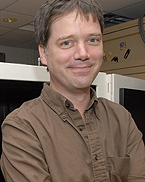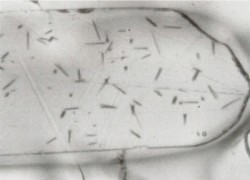Code Talker: Rich ketcham gets with the program
December 19, 2009

Richard Ketcham had a knack for computer programming, but didn’t want a career that would keep him stuck inside. Computers didn’t seem terribly fulfilling, especially since his main experience with them had been writing programs for things like balancing a company’s books. During his senior year at Williams College, a professor asked him to stay for the summer and help him model heat flow during thrust faulting.
“He thought the big wigs were wrong about how it worked,” he says. “I spent this bucolic summer in the Berkshires figuring out how to do it.” In just the first couple of weeks, he had a working model that was already proving out the professor’s alternative theory.
“It showed me that I was pretty good at doing something that was out and out new,” he says. “I could program a computer to do something and as a result, I would know something that no one else knew before. That was my first experience with scientific discovery and that’s what had me hooked.” He graduated with a bachelor’s in geology and computer science, a marriage that has lasted more than 20 years.
Shake & Bake
One of the areas in which he’s applied these two fields to great effect is low-temperature thermochronology, a set of tools for reconstructing the thermal history of rocks based on the rate at which different radioactive isotopes decay and their daughter products are incrementally lost due to heating. The tools can help reveal when mountains were built, erosion occurred, faults shifted, and petroleum traps formed, among other things.
Ketcham developed a computer program that combines data from two of these tools—apatite fission-track and (U-Th)/He—to create a range of likely thermal histories for a particular sample. His program, called HeFTy, has become the standard tool used by researchers everywhere for interpreting those data. He was surprised when a researcher from Florida used it to examine a Martian meteorite discovered in Antarctica.

“This was a rock sitting around on Mars for billions of years, getting hit by a meteorite, being ejected into space, sitting around in space for a while, heating as it falls to Earth, hits Antarctica and sits there,” he says. The researcher used his program to infer temperatures on the surface of Mars at the time of ejection, the timing of major events in its odyssey, and what the entry in our atmosphere was like.
“I never had a clue that anyone would do anything remotely similar to that,” he says. “It actually made me improve the program in a number of ways, for example so that it could handle billion-year time scales and seconds-long events at the same time. I re-derived the equations and put everything on a much sounder basis and it actually made the program more robust.”
Ketcham is also intensely interested in what goes into his software—part of the reason he calls his program HeFTy (think: trash bags) is to remind himself and others of the computer truism “garbage in, garbage out.” He created a more accurate means of estimating fission-track annealing rates at geological time scales from laboratory-time-scale experiments, which has become the international standard. More recently, he also helped create a new model for helium diffusivity that accounts for radiation damage in the apatite grain, a leap forward for the (U-Th)/He technique.
Slice & Dice
Another area in which Ketcham has applied his computer programming prowess is in CT scanning geological and other natural and manmade specimens. As a graduate student at The University of Texas at Austin, he worked with Bill Carlson studying how crystals grow in metamorphic rocks. They took samples to a local company to have them scanned with a computed tomography (CT) scanner. The device uses an x-ray source to collect a series of slice images which can be combined into a 3D image revealing internal structure without cutting into the sample. Ketcham processed the raw CT data, reconstructed where crystals were within the rock and developed models of crystal growth during metamorphism. Because it was unrelated to his Ph.D. work, he says it was like doing a second degree.
Several years later, Carlson, paleontology professor Tim Rowe, and anthropology professor John Kappelman began seeking funding to buy an industrial-grade CT scanner for the university. It would be the first such device dedicated to scientific research at a university. They invited Ketcham to run the new High Resolution X-ray CT Facility (UTCT).
Since then, they have scanned thousands of objects, many of them one-of-a-kind and irreplaceable, such as the braincase of Archaeopteryx (the oldest and most primitive bird known), one of the first books printed in the New World, a Martian meteorite believed by some to contain signs of alien life, space probe thrusters, and diamond-encrusted rocks from deep inside Earth. This groundbreaking work has established UT Austin as the leading center for scientific CT scanning. In September 2008, the team secretly scanned Lucy, a fossil skeleton of an ancient human ancestor.
Candy Man
After 11 years running UTCT, Ketcham has become an associate professor. He’s handed most of the day to day managing of the lab over to a colleague while continuing in his role as one of three directors of the lab.
“Working in the CT lab is like being a kid in a candy store,” he says, referring to the continual flow of world-class specimens to be scanned and interesting problems to be solved. “And 11 years in a candy store is not necessarily healthy.”
He wanted a way to impart his practical research experience to students. He was also bursting with research ideas that he realized he would never have time to complete on his own.
“Instructing students in research, you get young energetic minds to follow up on stuff that you just don’t have time for or stuff that you’re just not going to learn well enough yourself,” he says.
One of his favorite experiences so far has been to co-teach an introductory geology course with Leon Long, a legend in the department who has inspired students for several decades.
“Leon has much to teach us about being an effective instructor,” he says. “Teaching is an art and I’m just getting started.”
by Marc Airhart
For more information about the Jackson School contact J.B. Bird at jbird@jsg.utexas.edu, 512-232-9623.
